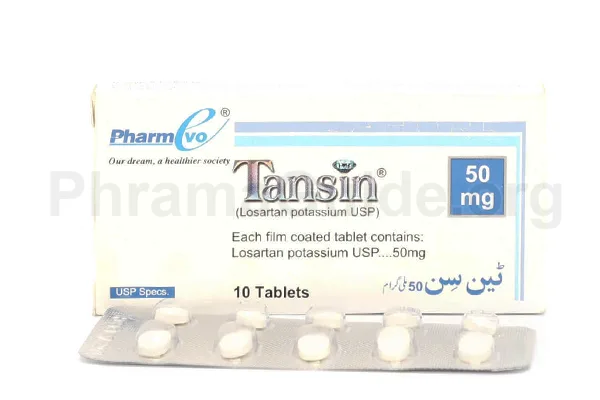Tansin tablet belongs to a class of drugs called angiotensin II receptor blockers (ARBs). It is primarily used for the treatment of hypertension (high blood pressure) and certain cardiac problems, including:
- Hypertension (high blood pressure): Tansin is commonly used to lower blood pressure and manage hypertension. It works by blocking the action of angiotensin II, a hormone that causes blood vessels to constrict, and promotes the release of another hormone called aldosterone, which leads to increased salt and water retention. By blocking the effects of angiotensin II, Tansin helps relax blood vessels and lower blood pressure.
- Reduction of Stroke Risk: Tansin may be used in individuals with hypertension who are at risk of stroke. By lowering blood pressure, it can help reduce the risk of stroke associated with hypertension.
- Diabetic Nephropathy: Tansin is also used to treat diabetic nephropathy, a kidney condition that occurs as a result of long-term diabetes. It can help delay the progression of kidney damage in individuals with type 2 diabetes and high blood pressure.
- Heart Failure: In certain cases, Tansin may be used as part of the treatment for heart failure. It can help improve symptoms, reduce the risk of hospitalization, and potentially slow the progression of the condition.
Off-label Uses of Tansin Tablet
- Marfan Syndrome: Tansin has shown potential in the management of Marfan syndrome, a genetic disorder affecting connective tissue. It has been suggested that using Tansin may help slow the progression of aortic enlargement, a common complication of Marfan syndrome, by blocking certain signaling pathways involved in vascular remodeling. However, further research is needed to establish its effectiveness and safety in this context.
- Polycystic Kidney Disease (PKD): Tansin is used off-label in individuals with autosomal dominant polycystic kidney disease (ADPKD). The use of Tansin may help reduce the growth of kidney cysts and delay the progression of kidney damage in ADPKD. However, more research is needed to determine its optimal use and long-term effects in this condition.
- Migraine Prophylaxis: Using Tansin may have a beneficial effect in reducing the frequency and severity of migraines in some individuals. However, its use for migraine prophylaxis is considered off-label, and more research is required to establish its efficacy and safety compared to standard migraine prophylactic agents.
- Diabetic Retinopathy: Tansin is used as a potential treatment for diabetic retinopathy, a complication of diabetes that affects the blood vessels in the retina. Some clinical trials suggest that the use of Tansin may help slow the progression of diabetic retinopathy by reducing inflammation and improving vascular function. However, further studies are needed to confirm its effectiveness and optimal dosing.

What is Tansin?
Tansin is one of the leading brands of Losartan Potassium, manufactured and marketed by Pharmevo Pakistan (Pvt) Ltd.
Tansin Alternatives : Other Similar Brands
The following are some alternative brands of Tansin and their manufacturers.
- A2A : Wilson Pharmaceuticals, Pakistan.
- Eziday : Werrick Pharmaceuticals, Pakistan.
- Xavor : Ferozsons Laboratories Ltd, Pakistan.
- Losar K : Platinum Pharmaceuticals (Pvt) Ltd, Pakistan.
- Sar K : Saffron Pharmaceuticals (Pvt) Ltd, Pakistan.
- Losartan : Don Valley Pharmaceuticals (Pvt) Ltd, Pakistan.
- Losan : Wilshire Laboratories (Pvt) Ltd, Pakistan.
- Bepsar : Nabiqasim Industries (Pvt) Ltd, Pakistan.
- Cozaar : Merck Sharp & Dome (Pakistan) Ltd.
- Zostat : Himont Pharmaceuticals (Pvt) Ltd, Pakistan.
Tansin : Available Formulations and Strengths
Presently, Tansin is available in Tablet Form.
Tansin Tablet : 50mg strength.
Who Should Not Use Tansin?
Tansin, like any medication, has certain contraindications, which are specific situations or conditions where its use is not recommended due to potential risks or adverse effects.
- Allergy or hypersensitivity: Tansin should not be used in individuals who have a known allergy or hypersensitivity to Tansin or any other components of the medication. Allergic reactions can range from mild skin rash to severe anaphylaxis, which is a life-threatening allergic reaction.
- Pregnancy: Tansin is contraindicated during pregnancy. It can cause harm or even fetal death when used during the second and third trimesters. It is important to inform your healthcare professional if you are pregnant or planning to become pregnant before starting or continuing Tansin treatment.
- Severe renal impairment: Tansin should be used with caution or avoided in individuals with severe renal impairment (very poor kidney function) or end-stage renal disease. The dosage may need to be adjusted or alternative treatments considered.
- Severe hepatic impairment: Tansin should be used with caution in individuals with severe hepatic impairment (severe liver disease). The dosage may need to be adjusted, and regular liver function monitoring may be necessary.
- Bilateral renal artery stenosis or a single functioning kidney: Tansin is generally not recommended in individuals with bilateral renal artery stenosis (narrowing of both renal arteries) or those with a single functioning kidney. It may reduce kidney blood flow and lead to further kidney problems in these individuals.
- Hypotension (low blood pressure): Tansin should be used cautiously in individuals with hypotension or those at risk of hypotension. It can further lower blood pressure, leading to symptoms such as dizziness, lightheadedness, or fainting.
What is the Recommended Daily Dosage of Tansin?
Tansin Dose for Hypertension (high blood pressure):
- One Tablet of 50mg, once daily.
- The dosage may be increased to a maximum of 100mg (2 Tablets of Tansin) once daily based on the individual’s blood pressure response.
Tansin Dose for Reduction of stroke risk:
- One Tablet of 50mg, once daily.
Tansin Dose for Diabetic Nephropathy:
- 1 to 2 Tablets of 50mg, once daily.
How Tansin Works?
Tansin works by blocking the action of a hormone called angiotensin II. Angiotensin II is a potent vasoconstrictor, meaning it causes blood vessels to narrow and constrict. By blocking the effects of angiotensin II, it helps to relax and widen blood vessels, resulting in a decrease in blood pressure.

Leave A Comment